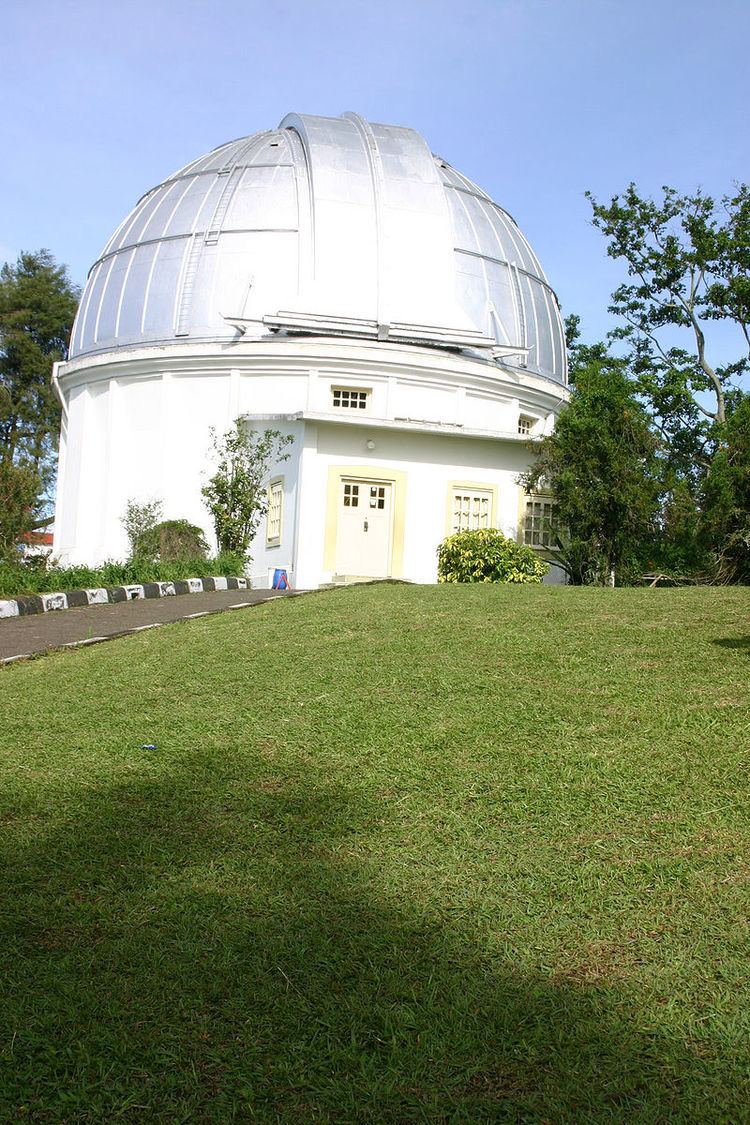Code 299 Established 1923 Zeiss Telescope 60 cm Double Refractor | Altitude 1,310 m (4,296 ft) Website bosscha.itb.ac.id Phone +62 22 2786001 | |
 | ||
Hours Open today · 9–10:30AM, 11AM–12:30PM, 1–2:30PMFriday9–10:30AM, 11AM–12:30PM, 1–2:30PMSaturday9AM–1PMSundayClosedMondayClosedTuesday9–10:30AM, 11AM–12:30PM, 1–2:30PMWednesday9–10:30AM, 11AM–12:30PM, 1–2:30PMThursday9–10:30AM, 11AM–12:30PM, 1–2:30PM Organization Bandung Institute of Technology Similar Tangkuban Perahu, De' Ranch, Bandung Geological Museum, Maribaya, Floating Market Lembang Profiles | ||
Bosscha Observatory is the oldest observatory in Indonesia. The observatory is located in Lembang, West Java, approximately 15 kilometers (9.3 mi) north of Bandung. It is situated on a hilly six hectares of land and is 1,310 m (4,300 ft) above mean sea level plateau. The IAU observatory code for Bosscha is 299.
Contents
- Menjelajahi bosscha observatory by lina fatinah
- History
- Facilities
- Directors
- In popular culture
- References
Menjelajahi bosscha observatory by lina fatinah
History
During the first meeting of the Nederlandsch-Indische Sterrekundige Vereeniging (Dutch-Indies Astronomical Society) in the 1920s, it was agreed that an observatory was needed to study astronomy in the Dutch East Indies. Of all locations in the Indonesia archipelago, a tea plantation in Malabar, a few kilometers north of Bandung in West Java was selected. It is on the hilly north side of the city with a non-obstructed view of the sky and with close access to the city that was planned to become the new capital of the Dutch colony, replacing Batavia (present-day Jakarta). The observatory is named after the tea plantation owner Karel Albert Rudolf Bosscha, son of the physicist Johannes Bosscha and a major force in the development of science and technology in the Dutch East Indies, who granted six hectares of his property for the new observatory.
Construction of the observatory began in 1923 and was completed in 1928. Since then a continuous observation of the sky was made. The first international publication from Bosscha was published in 1922. Observations from Bosscha were halted during World War II and after the war a major reconstruction was necessary. On 17 October 1951, the Dutch-Indies Astronomical Society handed over operation of the observatory to the government of Indonesia. In 1959 the observatory's operation was given to the Institut Teknologi Bandung and has been an integral part of the research and formal education of astronomy in Indonesia.
Facilities
Five large telescopes were installed in Bosscha:
- The Zeiss double refractor
- The Schmidt telescope (nicknamed: Bima Sakti telescope)This telescope is used to study galactic structure, stellar spectra, asteroid studies, supernovae, and to photograph heavy bodies. The main lens diameter is 71.12 cm (28.00 in), the correcting bi-concave and convex lens is 50 cm (20 in) with a focal length of 2.5 m (8.2 ft). It is also equipped with a spectral prism with a prime angle of 6.10 degrees for stellar spectra, a wedge sensitometer and a film recorder.
- The Bamberg refractor
- The Cassegrain GOTO
- The Unitron refractor
Directors
1923 - 1940 : Dr. J. Voûte
1940 - 1942 : Dr. Aernout de Sitter
1942 - 1946 : Prof. Dr. Masashi Miyaji
1946 - 1949 : Prof. Dr. J. Hins
1949 - 1958 : Prof. Dr. Gale Bruno van Albada
1958 - 1959 : Prof. Dr. Ping Hok Ong and Santoso Nitisastro (temporary officers)
1959 - 1968 : Prof. Dr. The Pik Sin
1968 - 1999 : Prof. Dr. Bambang Hidayat
1999 - 2004 : Dr. Moedji Raharto
2004 - 2006 : Dr. Dhani Herdiwijaya
2006 - 2009 : Prof. Dr. Taufiq Hidayat
2009 - 2012 : Dr. Hakim L. Malasan
2012 - present: Dr. Mahasena Putra
In popular culture
The popular American reality TV Series The Amazing Race 23 has used this site as a pit stop for its 9th leg. The episode that used this site for filming has been nominated for the Emmys for several categories.
